HI6028 Taxation Law: Income Tax, CGT & Real-Life Problem Solving
VerifiedAdded on 2023/03/31
|9
|2084
|379
Report
AI Summary
This assignment addresses key issues in taxation law, specifically focusing on Capital Gains Tax (CGT) implications and the concept of income from personal exertion. It analyzes scenarios involving the sale of assets and income earned through writing and intellectual property. The first question examines the CGT consequences of Helen's asset sales, applying relevant sections of the Income Tax Assessment Act 1997 to determine tax liabilities and exemptions. The second question assesses whether Barbara's income from writing and selling copyrights and manuscripts constitutes income from personal exertion under the Income Tax Assessment Act 1936. The final question evaluates the tax implications of financial arrangements between Patrick and his son David, determining whether the received funds constitute assessable income based on established legal principles and sections of the Income Tax Assessment Act 1997. This assignment thoroughly applies taxation principles to real-life problems, demonstrating a comprehensive understanding of Australian income tax law.
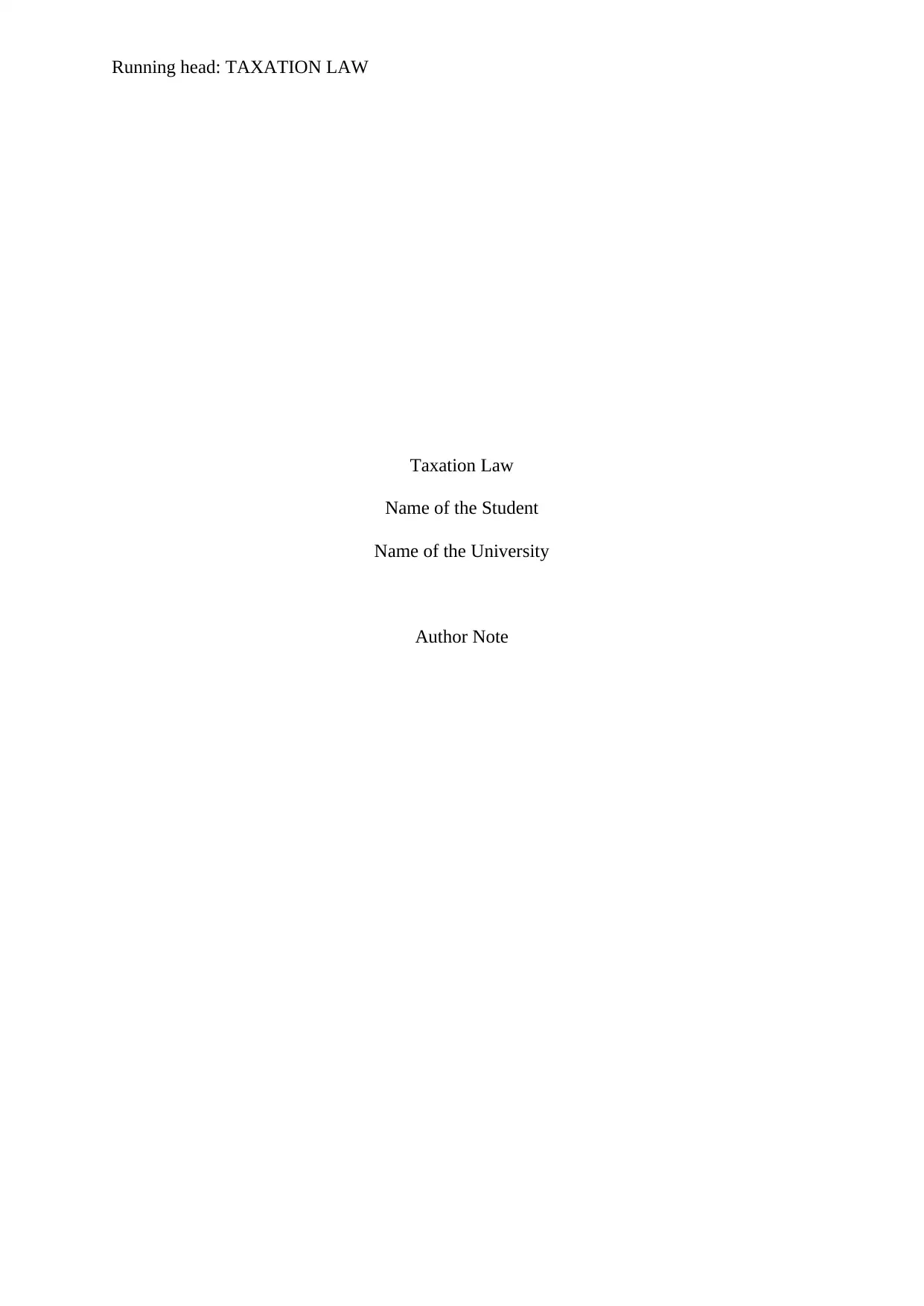
Running head: TAXATION LAW
Taxation Law
Name of the Student
Name of the University
Author Note
Taxation Law
Name of the Student
Name of the University
Author Note
Paraphrase This Document
Need a fresh take? Get an instant paraphrase of this document with our AI Paraphraser
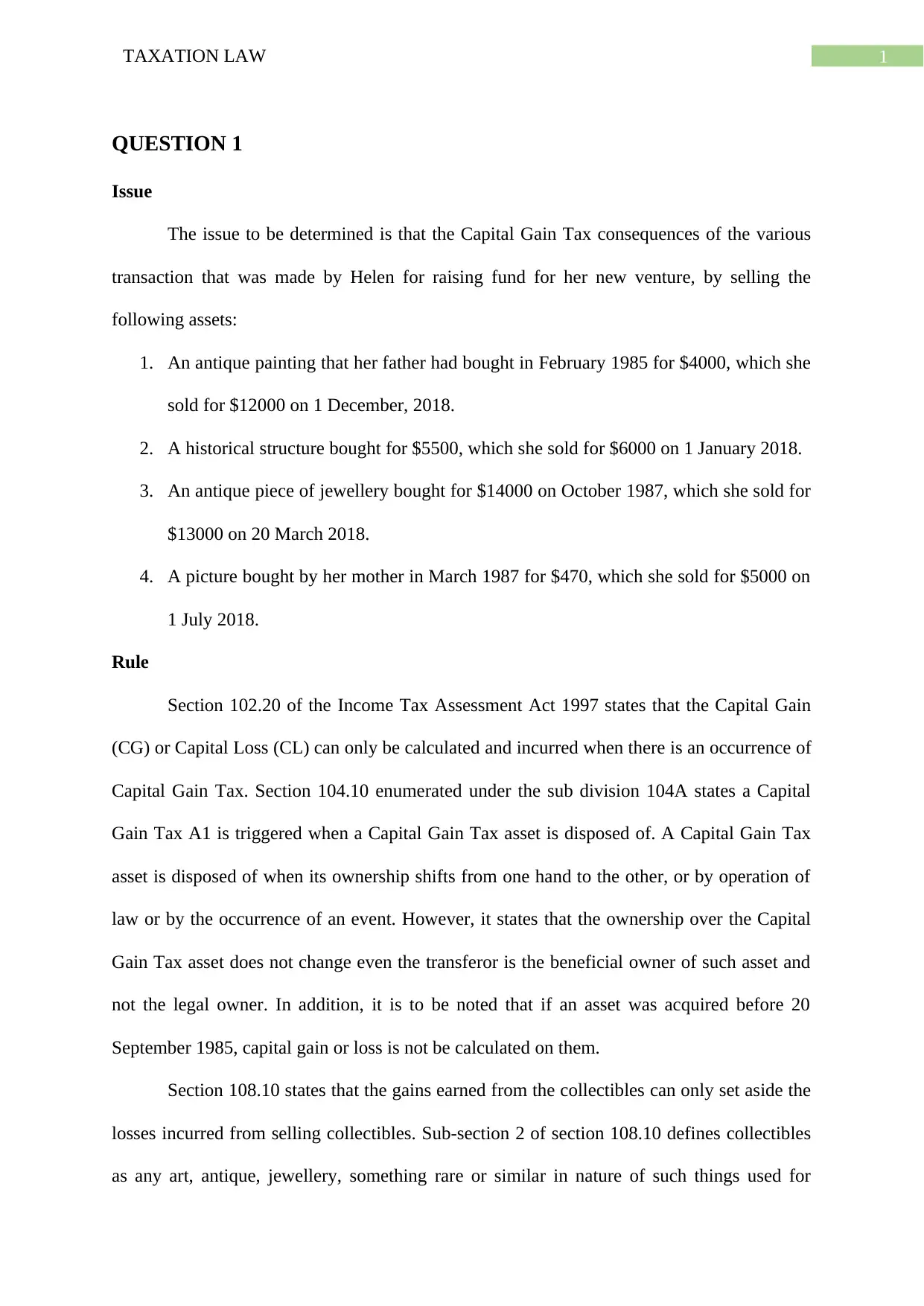
1TAXATION LAW
QUESTION 1
Issue
The issue to be determined is that the Capital Gain Tax consequences of the various
transaction that was made by Helen for raising fund for her new venture, by selling the
following assets:
1. An antique painting that her father had bought in February 1985 for $4000, which she
sold for $12000 on 1 December, 2018.
2. A historical structure bought for $5500, which she sold for $6000 on 1 January 2018.
3. An antique piece of jewellery bought for $14000 on October 1987, which she sold for
$13000 on 20 March 2018.
4. A picture bought by her mother in March 1987 for $470, which she sold for $5000 on
1 July 2018.
Rule
Section 102.20 of the Income Tax Assessment Act 1997 states that the Capital Gain
(CG) or Capital Loss (CL) can only be calculated and incurred when there is an occurrence of
Capital Gain Tax. Section 104.10 enumerated under the sub division 104A states a Capital
Gain Tax A1 is triggered when a Capital Gain Tax asset is disposed of. A Capital Gain Tax
asset is disposed of when its ownership shifts from one hand to the other, or by operation of
law or by the occurrence of an event. However, it states that the ownership over the Capital
Gain Tax asset does not change even the transferor is the beneficial owner of such asset and
not the legal owner. In addition, it is to be noted that if an asset was acquired before 20
September 1985, capital gain or loss is not be calculated on them.
Section 108.10 states that the gains earned from the collectibles can only set aside the
losses incurred from selling collectibles. Sub-section 2 of section 108.10 defines collectibles
as any art, antique, jewellery, something rare or similar in nature of such things used for
QUESTION 1
Issue
The issue to be determined is that the Capital Gain Tax consequences of the various
transaction that was made by Helen for raising fund for her new venture, by selling the
following assets:
1. An antique painting that her father had bought in February 1985 for $4000, which she
sold for $12000 on 1 December, 2018.
2. A historical structure bought for $5500, which she sold for $6000 on 1 January 2018.
3. An antique piece of jewellery bought for $14000 on October 1987, which she sold for
$13000 on 20 March 2018.
4. A picture bought by her mother in March 1987 for $470, which she sold for $5000 on
1 July 2018.
Rule
Section 102.20 of the Income Tax Assessment Act 1997 states that the Capital Gain
(CG) or Capital Loss (CL) can only be calculated and incurred when there is an occurrence of
Capital Gain Tax. Section 104.10 enumerated under the sub division 104A states a Capital
Gain Tax A1 is triggered when a Capital Gain Tax asset is disposed of. A Capital Gain Tax
asset is disposed of when its ownership shifts from one hand to the other, or by operation of
law or by the occurrence of an event. However, it states that the ownership over the Capital
Gain Tax asset does not change even the transferor is the beneficial owner of such asset and
not the legal owner. In addition, it is to be noted that if an asset was acquired before 20
September 1985, capital gain or loss is not be calculated on them.
Section 108.10 states that the gains earned from the collectibles can only set aside the
losses incurred from selling collectibles. Sub-section 2 of section 108.10 defines collectibles
as any art, antique, jewellery, something rare or similar in nature of such things used for
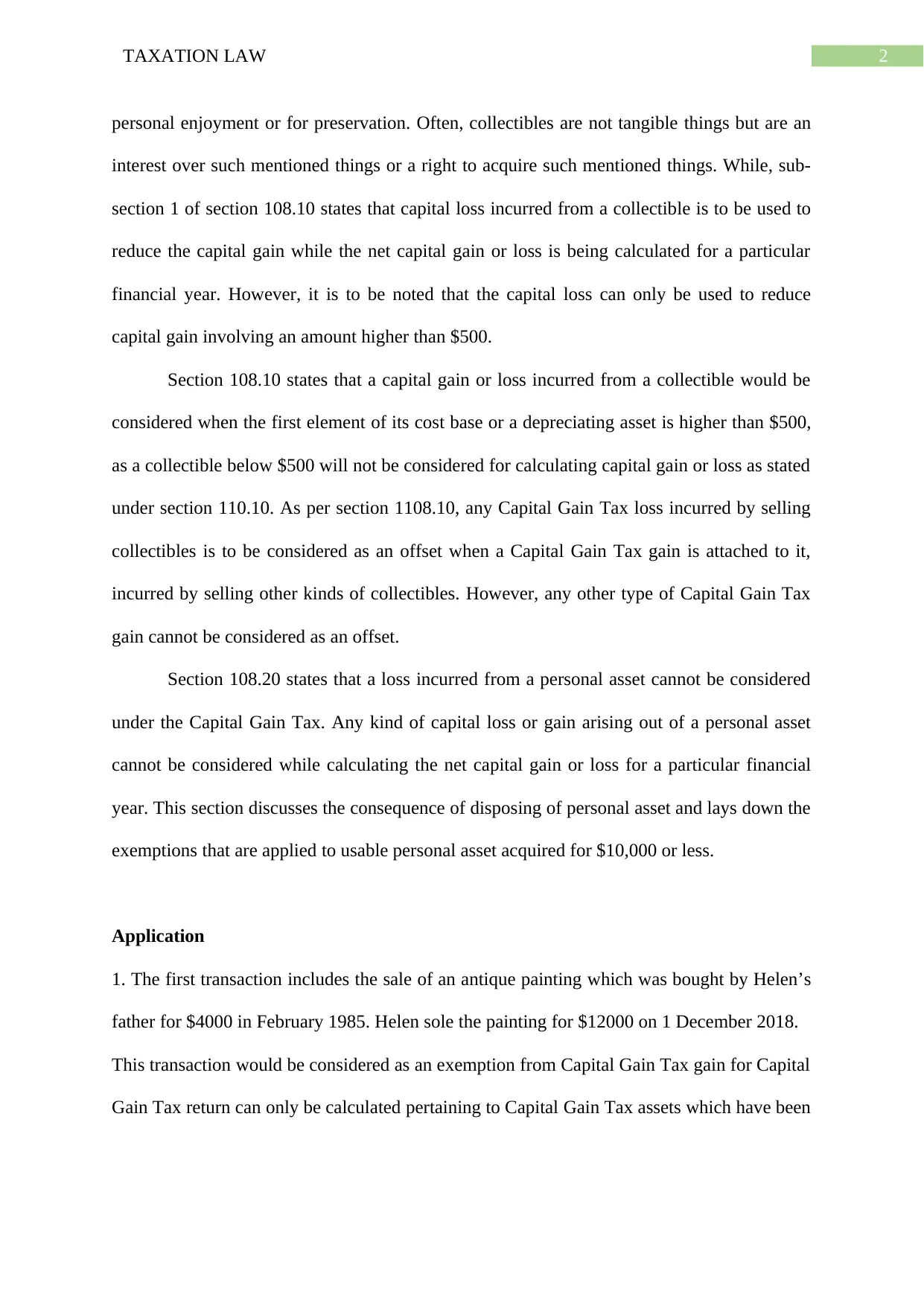
2TAXATION LAW
personal enjoyment or for preservation. Often, collectibles are not tangible things but are an
interest over such mentioned things or a right to acquire such mentioned things. While, sub-
section 1 of section 108.10 states that capital loss incurred from a collectible is to be used to
reduce the capital gain while the net capital gain or loss is being calculated for a particular
financial year. However, it is to be noted that the capital loss can only be used to reduce
capital gain involving an amount higher than $500.
Section 108.10 states that a capital gain or loss incurred from a collectible would be
considered when the first element of its cost base or a depreciating asset is higher than $500,
as a collectible below $500 will not be considered for calculating capital gain or loss as stated
under section 110.10. As per section 1108.10, any Capital Gain Tax loss incurred by selling
collectibles is to be considered as an offset when a Capital Gain Tax gain is attached to it,
incurred by selling other kinds of collectibles. However, any other type of Capital Gain Tax
gain cannot be considered as an offset.
Section 108.20 states that a loss incurred from a personal asset cannot be considered
under the Capital Gain Tax. Any kind of capital loss or gain arising out of a personal asset
cannot be considered while calculating the net capital gain or loss for a particular financial
year. This section discusses the consequence of disposing of personal asset and lays down the
exemptions that are applied to usable personal asset acquired for $10,000 or less.
Application
1. The first transaction includes the sale of an antique painting which was bought by Helen’s
father for $4000 in February 1985. Helen sole the painting for $12000 on 1 December 2018.
This transaction would be considered as an exemption from Capital Gain Tax gain for Capital
Gain Tax return can only be calculated pertaining to Capital Gain Tax assets which have been
personal enjoyment or for preservation. Often, collectibles are not tangible things but are an
interest over such mentioned things or a right to acquire such mentioned things. While, sub-
section 1 of section 108.10 states that capital loss incurred from a collectible is to be used to
reduce the capital gain while the net capital gain or loss is being calculated for a particular
financial year. However, it is to be noted that the capital loss can only be used to reduce
capital gain involving an amount higher than $500.
Section 108.10 states that a capital gain or loss incurred from a collectible would be
considered when the first element of its cost base or a depreciating asset is higher than $500,
as a collectible below $500 will not be considered for calculating capital gain or loss as stated
under section 110.10. As per section 1108.10, any Capital Gain Tax loss incurred by selling
collectibles is to be considered as an offset when a Capital Gain Tax gain is attached to it,
incurred by selling other kinds of collectibles. However, any other type of Capital Gain Tax
gain cannot be considered as an offset.
Section 108.20 states that a loss incurred from a personal asset cannot be considered
under the Capital Gain Tax. Any kind of capital loss or gain arising out of a personal asset
cannot be considered while calculating the net capital gain or loss for a particular financial
year. This section discusses the consequence of disposing of personal asset and lays down the
exemptions that are applied to usable personal asset acquired for $10,000 or less.
Application
1. The first transaction includes the sale of an antique painting which was bought by Helen’s
father for $4000 in February 1985. Helen sole the painting for $12000 on 1 December 2018.
This transaction would be considered as an exemption from Capital Gain Tax gain for Capital
Gain Tax return can only be calculated pertaining to Capital Gain Tax assets which have been
⊘ This is a preview!⊘
Do you want full access?
Subscribe today to unlock all pages.

Trusted by 1+ million students worldwide
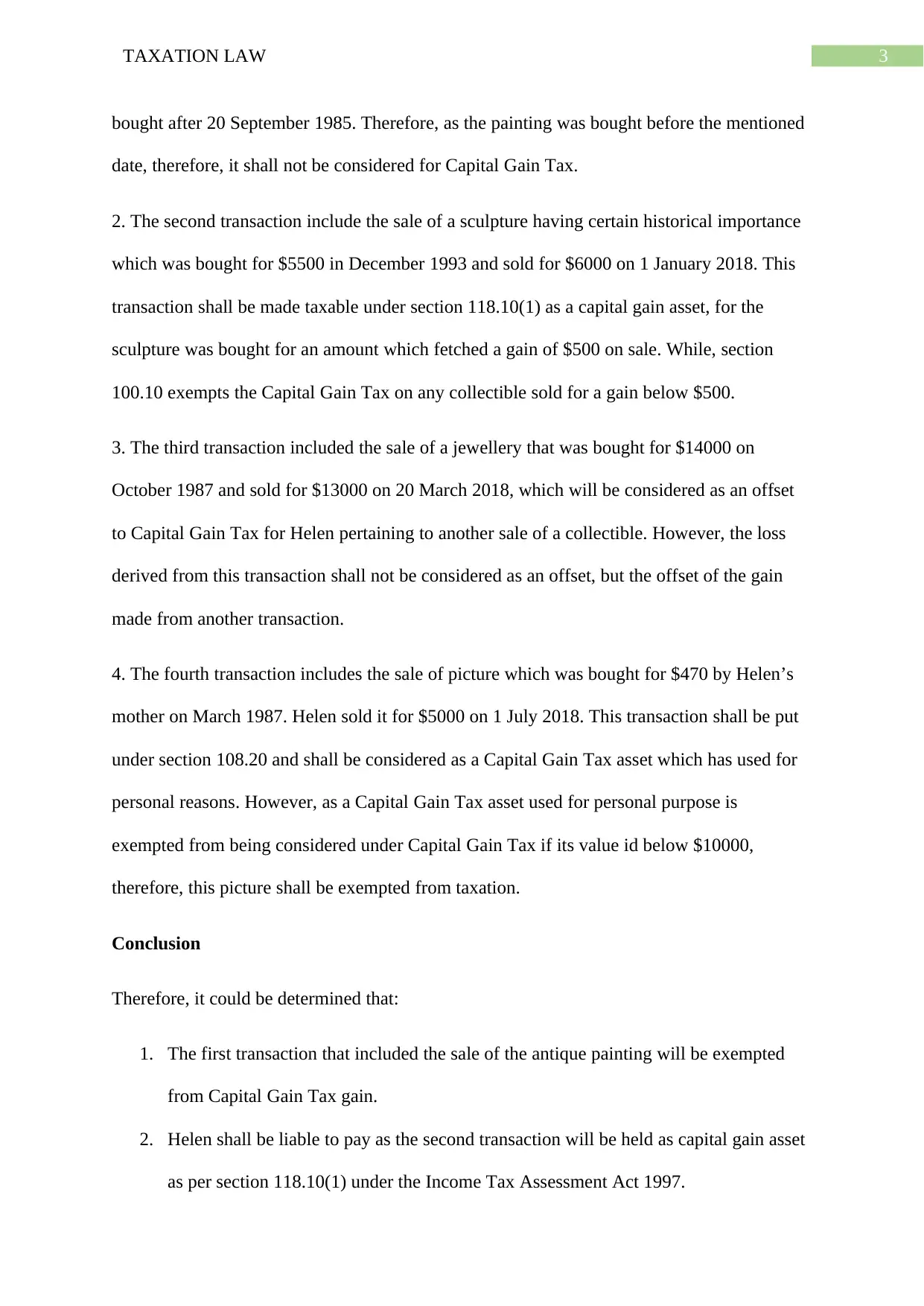
3TAXATION LAW
bought after 20 September 1985. Therefore, as the painting was bought before the mentioned
date, therefore, it shall not be considered for Capital Gain Tax.
2. The second transaction include the sale of a sculpture having certain historical importance
which was bought for $5500 in December 1993 and sold for $6000 on 1 January 2018. This
transaction shall be made taxable under section 118.10(1) as a capital gain asset, for the
sculpture was bought for an amount which fetched a gain of $500 on sale. While, section
100.10 exempts the Capital Gain Tax on any collectible sold for a gain below $500.
3. The third transaction included the sale of a jewellery that was bought for $14000 on
October 1987 and sold for $13000 on 20 March 2018, which will be considered as an offset
to Capital Gain Tax for Helen pertaining to another sale of a collectible. However, the loss
derived from this transaction shall not be considered as an offset, but the offset of the gain
made from another transaction.
4. The fourth transaction includes the sale of picture which was bought for $470 by Helen’s
mother on March 1987. Helen sold it for $5000 on 1 July 2018. This transaction shall be put
under section 108.20 and shall be considered as a Capital Gain Tax asset which has used for
personal reasons. However, as a Capital Gain Tax asset used for personal purpose is
exempted from being considered under Capital Gain Tax if its value id below $10000,
therefore, this picture shall be exempted from taxation.
Conclusion
Therefore, it could be determined that:
1. The first transaction that included the sale of the antique painting will be exempted
from Capital Gain Tax gain.
2. Helen shall be liable to pay as the second transaction will be held as capital gain asset
as per section 118.10(1) under the Income Tax Assessment Act 1997.
bought after 20 September 1985. Therefore, as the painting was bought before the mentioned
date, therefore, it shall not be considered for Capital Gain Tax.
2. The second transaction include the sale of a sculpture having certain historical importance
which was bought for $5500 in December 1993 and sold for $6000 on 1 January 2018. This
transaction shall be made taxable under section 118.10(1) as a capital gain asset, for the
sculpture was bought for an amount which fetched a gain of $500 on sale. While, section
100.10 exempts the Capital Gain Tax on any collectible sold for a gain below $500.
3. The third transaction included the sale of a jewellery that was bought for $14000 on
October 1987 and sold for $13000 on 20 March 2018, which will be considered as an offset
to Capital Gain Tax for Helen pertaining to another sale of a collectible. However, the loss
derived from this transaction shall not be considered as an offset, but the offset of the gain
made from another transaction.
4. The fourth transaction includes the sale of picture which was bought for $470 by Helen’s
mother on March 1987. Helen sold it for $5000 on 1 July 2018. This transaction shall be put
under section 108.20 and shall be considered as a Capital Gain Tax asset which has used for
personal reasons. However, as a Capital Gain Tax asset used for personal purpose is
exempted from being considered under Capital Gain Tax if its value id below $10000,
therefore, this picture shall be exempted from taxation.
Conclusion
Therefore, it could be determined that:
1. The first transaction that included the sale of the antique painting will be exempted
from Capital Gain Tax gain.
2. Helen shall be liable to pay as the second transaction will be held as capital gain asset
as per section 118.10(1) under the Income Tax Assessment Act 1997.
Paraphrase This Document
Need a fresh take? Get an instant paraphrase of this document with our AI Paraphraser
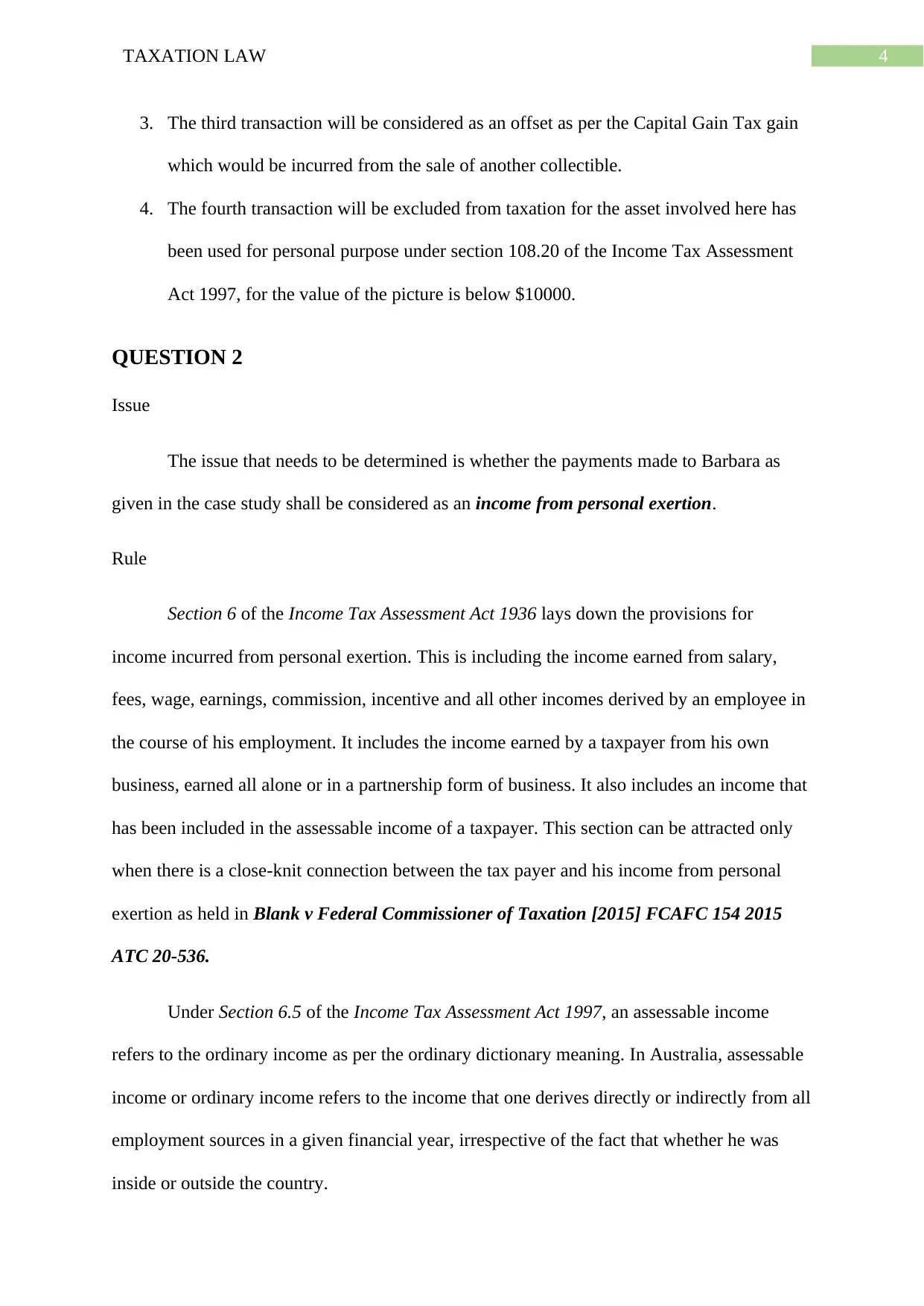
4TAXATION LAW
3. The third transaction will be considered as an offset as per the Capital Gain Tax gain
which would be incurred from the sale of another collectible.
4. The fourth transaction will be excluded from taxation for the asset involved here has
been used for personal purpose under section 108.20 of the Income Tax Assessment
Act 1997, for the value of the picture is below $10000.
QUESTION 2
Issue
The issue that needs to be determined is whether the payments made to Barbara as
given in the case study shall be considered as an income from personal exertion.
Rule
Section 6 of the Income Tax Assessment Act 1936 lays down the provisions for
income incurred from personal exertion. This is including the income earned from salary,
fees, wage, earnings, commission, incentive and all other incomes derived by an employee in
the course of his employment. It includes the income earned by a taxpayer from his own
business, earned all alone or in a partnership form of business. It also includes an income that
has been included in the assessable income of a taxpayer. This section can be attracted only
when there is a close-knit connection between the tax payer and his income from personal
exertion as held in Blank v Federal Commissioner of Taxation [2015] FCAFC 154 2015
ATC 20-536.
Under Section 6.5 of the Income Tax Assessment Act 1997, an assessable income
refers to the ordinary income as per the ordinary dictionary meaning. In Australia, assessable
income or ordinary income refers to the income that one derives directly or indirectly from all
employment sources in a given financial year, irrespective of the fact that whether he was
inside or outside the country.
3. The third transaction will be considered as an offset as per the Capital Gain Tax gain
which would be incurred from the sale of another collectible.
4. The fourth transaction will be excluded from taxation for the asset involved here has
been used for personal purpose under section 108.20 of the Income Tax Assessment
Act 1997, for the value of the picture is below $10000.
QUESTION 2
Issue
The issue that needs to be determined is whether the payments made to Barbara as
given in the case study shall be considered as an income from personal exertion.
Rule
Section 6 of the Income Tax Assessment Act 1936 lays down the provisions for
income incurred from personal exertion. This is including the income earned from salary,
fees, wage, earnings, commission, incentive and all other incomes derived by an employee in
the course of his employment. It includes the income earned by a taxpayer from his own
business, earned all alone or in a partnership form of business. It also includes an income that
has been included in the assessable income of a taxpayer. This section can be attracted only
when there is a close-knit connection between the tax payer and his income from personal
exertion as held in Blank v Federal Commissioner of Taxation [2015] FCAFC 154 2015
ATC 20-536.
Under Section 6.5 of the Income Tax Assessment Act 1997, an assessable income
refers to the ordinary income as per the ordinary dictionary meaning. In Australia, assessable
income or ordinary income refers to the income that one derives directly or indirectly from all
employment sources in a given financial year, irrespective of the fact that whether he was
inside or outside the country.

5TAXATION LAW
Copyright, on the other hand, is considered as a Capital Gain Tax asset which is
taxable and therefore, an income derived from selling such copyright shall be considered as a
Capital Gain Tax gain. However, if such copyright was incurred for personal purpose and
then it is sold for deriving profit, then it shall be considered as an ordinary income, as seen in
Commissioner of Taxation (Cth) v Whitfords Beach Pty Ltd [1982] HCA 8.
Application
In this case, the income earned by Barbara from the payment received from Eco
Books Company for writing an Economics book for $13000 shall be treated as an income by
personal exertion as held under Section 6 of the Income Tax Assessment Act 1936.
Barbara gave up her copyright on the book that she had written for Eco Books for
$13400, where such copyright shall be treated as Capital Gain Tax asset and therefore will be
taxable. In addition, the payment for the copyright was made after the book was published;
therefore it will be considered as Capital Gain Tax gain.
Barbara also sold the interview manuscripts that she had collected while writing her
Economics book to Eco Books Company for $3200 along with the manuscript of her
Economics books too for $4350, both of which will be regarded as income incurred from
personal exertion as per Section 6 of the Income Tax Assessment Act 1997.
However, even if Barbara had written the Economics book in her leisure time, it
would still be considered as Capital Gain Tax asset and the income incurred out of it would
be an income incurred from personal exertion.
Conclusion
Therefore, to conclude, all the incomes incurred by Barbara in this case study shall be
considered as an income from personal exertion.
Copyright, on the other hand, is considered as a Capital Gain Tax asset which is
taxable and therefore, an income derived from selling such copyright shall be considered as a
Capital Gain Tax gain. However, if such copyright was incurred for personal purpose and
then it is sold for deriving profit, then it shall be considered as an ordinary income, as seen in
Commissioner of Taxation (Cth) v Whitfords Beach Pty Ltd [1982] HCA 8.
Application
In this case, the income earned by Barbara from the payment received from Eco
Books Company for writing an Economics book for $13000 shall be treated as an income by
personal exertion as held under Section 6 of the Income Tax Assessment Act 1936.
Barbara gave up her copyright on the book that she had written for Eco Books for
$13400, where such copyright shall be treated as Capital Gain Tax asset and therefore will be
taxable. In addition, the payment for the copyright was made after the book was published;
therefore it will be considered as Capital Gain Tax gain.
Barbara also sold the interview manuscripts that she had collected while writing her
Economics book to Eco Books Company for $3200 along with the manuscript of her
Economics books too for $4350, both of which will be regarded as income incurred from
personal exertion as per Section 6 of the Income Tax Assessment Act 1997.
However, even if Barbara had written the Economics book in her leisure time, it
would still be considered as Capital Gain Tax asset and the income incurred out of it would
be an income incurred from personal exertion.
Conclusion
Therefore, to conclude, all the incomes incurred by Barbara in this case study shall be
considered as an income from personal exertion.
⊘ This is a preview!⊘
Do you want full access?
Subscribe today to unlock all pages.

Trusted by 1+ million students worldwide
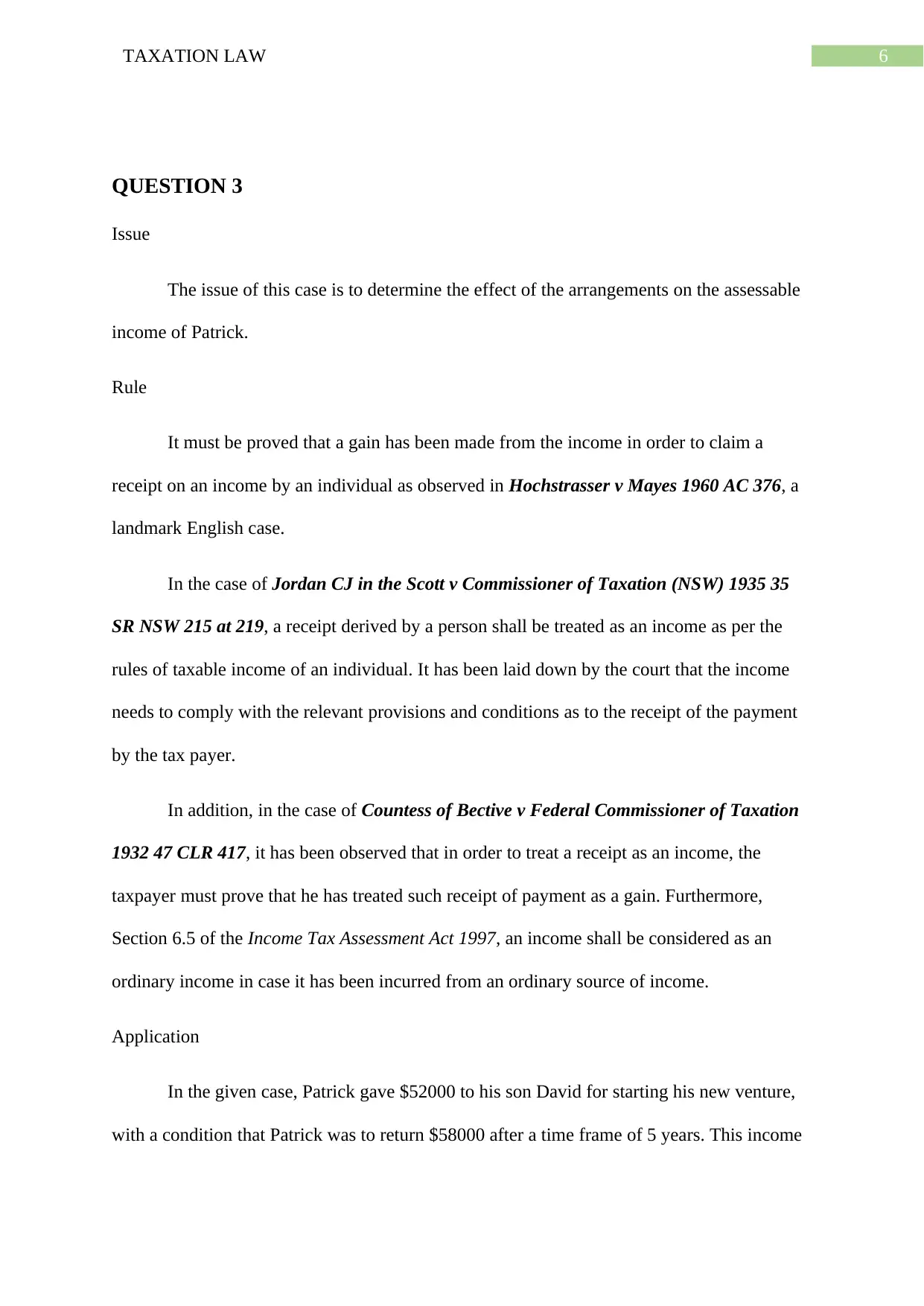
6TAXATION LAW
QUESTION 3
Issue
The issue of this case is to determine the effect of the arrangements on the assessable
income of Patrick.
Rule
It must be proved that a gain has been made from the income in order to claim a
receipt on an income by an individual as observed in Hochstrasser v Mayes 1960 AC 376, a
landmark English case.
In the case of Jordan CJ in the Scott v Commissioner of Taxation (NSW) 1935 35
SR NSW 215 at 219, a receipt derived by a person shall be treated as an income as per the
rules of taxable income of an individual. It has been laid down by the court that the income
needs to comply with the relevant provisions and conditions as to the receipt of the payment
by the tax payer.
In addition, in the case of Countess of Bective v Federal Commissioner of Taxation
1932 47 CLR 417, it has been observed that in order to treat a receipt as an income, the
taxpayer must prove that he has treated such receipt of payment as a gain. Furthermore,
Section 6.5 of the Income Tax Assessment Act 1997, an income shall be considered as an
ordinary income in case it has been incurred from an ordinary source of income.
Application
In the given case, Patrick gave $52000 to his son David for starting his new venture,
with a condition that Patrick was to return $58000 after a time frame of 5 years. This income
QUESTION 3
Issue
The issue of this case is to determine the effect of the arrangements on the assessable
income of Patrick.
Rule
It must be proved that a gain has been made from the income in order to claim a
receipt on an income by an individual as observed in Hochstrasser v Mayes 1960 AC 376, a
landmark English case.
In the case of Jordan CJ in the Scott v Commissioner of Taxation (NSW) 1935 35
SR NSW 215 at 219, a receipt derived by a person shall be treated as an income as per the
rules of taxable income of an individual. It has been laid down by the court that the income
needs to comply with the relevant provisions and conditions as to the receipt of the payment
by the tax payer.
In addition, in the case of Countess of Bective v Federal Commissioner of Taxation
1932 47 CLR 417, it has been observed that in order to treat a receipt as an income, the
taxpayer must prove that he has treated such receipt of payment as a gain. Furthermore,
Section 6.5 of the Income Tax Assessment Act 1997, an income shall be considered as an
ordinary income in case it has been incurred from an ordinary source of income.
Application
In the given case, Patrick gave $52000 to his son David for starting his new venture,
with a condition that Patrick was to return $58000 after a time frame of 5 years. This income
Paraphrase This Document
Need a fresh take? Get an instant paraphrase of this document with our AI Paraphraser
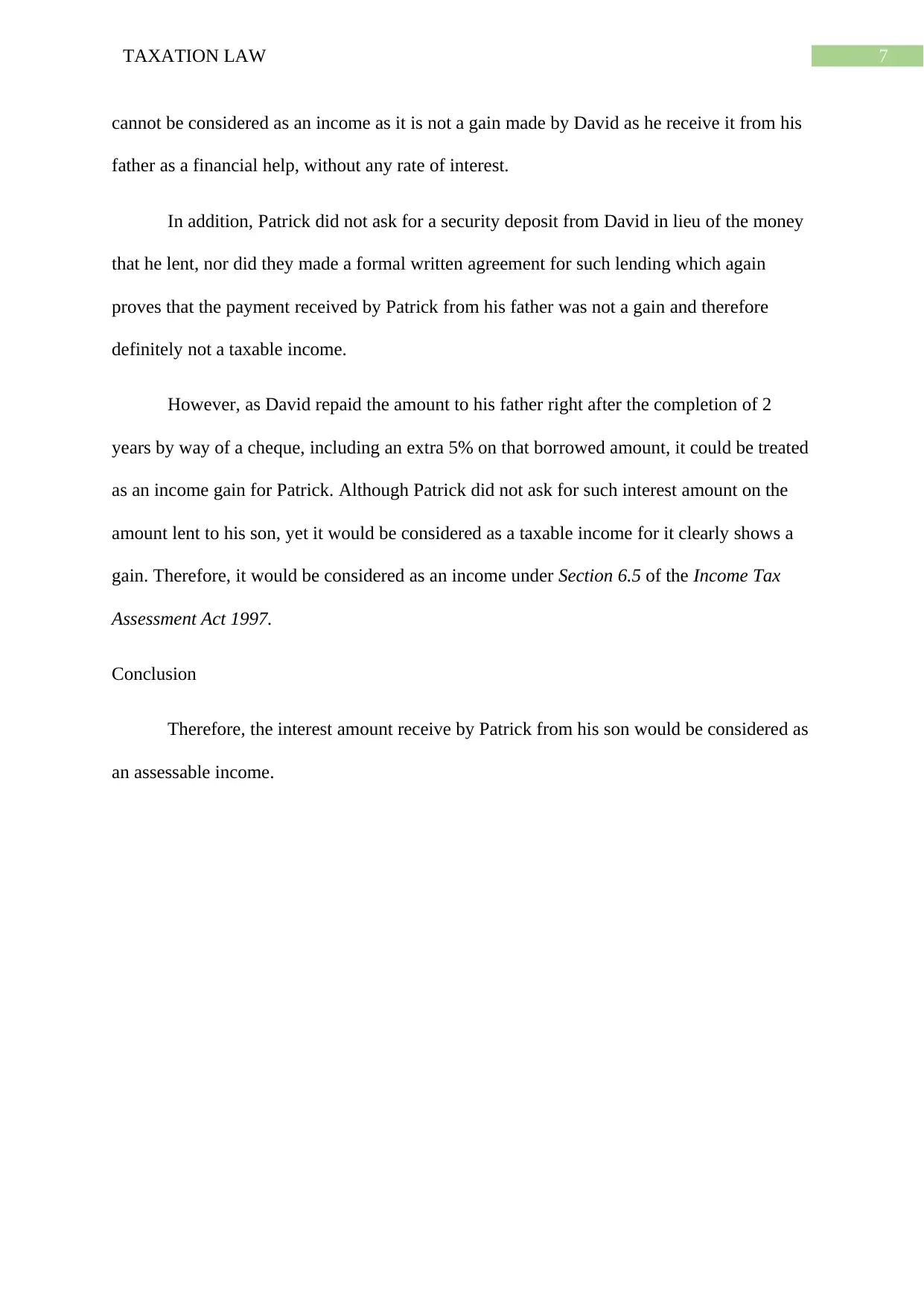
7TAXATION LAW
cannot be considered as an income as it is not a gain made by David as he receive it from his
father as a financial help, without any rate of interest.
In addition, Patrick did not ask for a security deposit from David in lieu of the money
that he lent, nor did they made a formal written agreement for such lending which again
proves that the payment received by Patrick from his father was not a gain and therefore
definitely not a taxable income.
However, as David repaid the amount to his father right after the completion of 2
years by way of a cheque, including an extra 5% on that borrowed amount, it could be treated
as an income gain for Patrick. Although Patrick did not ask for such interest amount on the
amount lent to his son, yet it would be considered as a taxable income for it clearly shows a
gain. Therefore, it would be considered as an income under Section 6.5 of the Income Tax
Assessment Act 1997.
Conclusion
Therefore, the interest amount receive by Patrick from his son would be considered as
an assessable income.
cannot be considered as an income as it is not a gain made by David as he receive it from his
father as a financial help, without any rate of interest.
In addition, Patrick did not ask for a security deposit from David in lieu of the money
that he lent, nor did they made a formal written agreement for such lending which again
proves that the payment received by Patrick from his father was not a gain and therefore
definitely not a taxable income.
However, as David repaid the amount to his father right after the completion of 2
years by way of a cheque, including an extra 5% on that borrowed amount, it could be treated
as an income gain for Patrick. Although Patrick did not ask for such interest amount on the
amount lent to his son, yet it would be considered as a taxable income for it clearly shows a
gain. Therefore, it would be considered as an income under Section 6.5 of the Income Tax
Assessment Act 1997.
Conclusion
Therefore, the interest amount receive by Patrick from his son would be considered as
an assessable income.
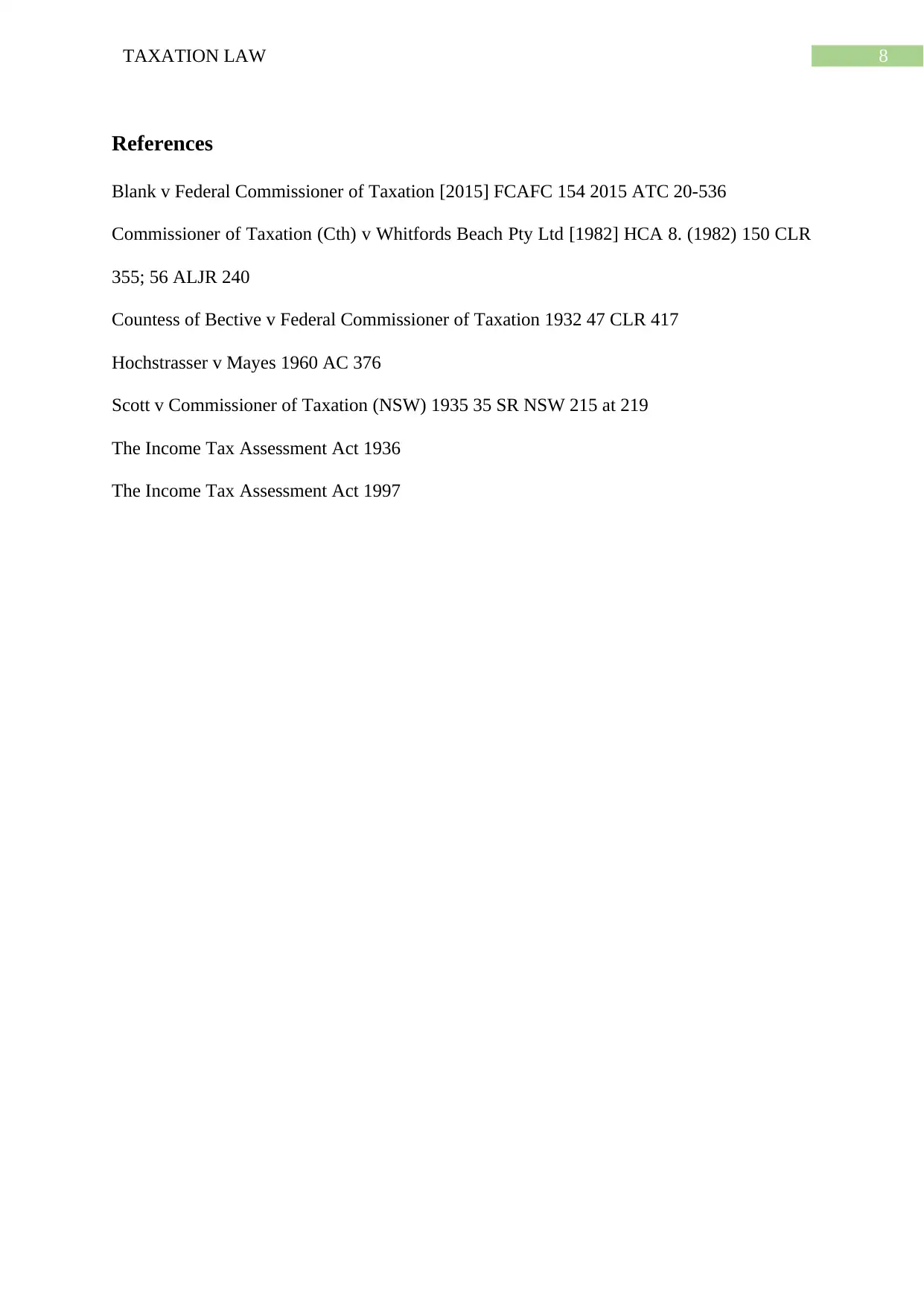
8TAXATION LAW
References
Blank v Federal Commissioner of Taxation [2015] FCAFC 154 2015 ATC 20-536
Commissioner of Taxation (Cth) v Whitfords Beach Pty Ltd [1982] HCA 8. (1982) 150 CLR
355; 56 ALJR 240
Countess of Bective v Federal Commissioner of Taxation 1932 47 CLR 417
Hochstrasser v Mayes 1960 AC 376
Scott v Commissioner of Taxation (NSW) 1935 35 SR NSW 215 at 219
The Income Tax Assessment Act 1936
The Income Tax Assessment Act 1997
References
Blank v Federal Commissioner of Taxation [2015] FCAFC 154 2015 ATC 20-536
Commissioner of Taxation (Cth) v Whitfords Beach Pty Ltd [1982] HCA 8. (1982) 150 CLR
355; 56 ALJR 240
Countess of Bective v Federal Commissioner of Taxation 1932 47 CLR 417
Hochstrasser v Mayes 1960 AC 376
Scott v Commissioner of Taxation (NSW) 1935 35 SR NSW 215 at 219
The Income Tax Assessment Act 1936
The Income Tax Assessment Act 1997
⊘ This is a preview!⊘
Do you want full access?
Subscribe today to unlock all pages.

Trusted by 1+ million students worldwide
1 out of 9
Related Documents
Your All-in-One AI-Powered Toolkit for Academic Success.
+13062052269
info@desklib.com
Available 24*7 on WhatsApp / Email
![[object Object]](/_next/static/media/star-bottom.7253800d.svg)
Unlock your academic potential
Copyright © 2020–2026 A2Z Services. All Rights Reserved. Developed and managed by ZUCOL.




